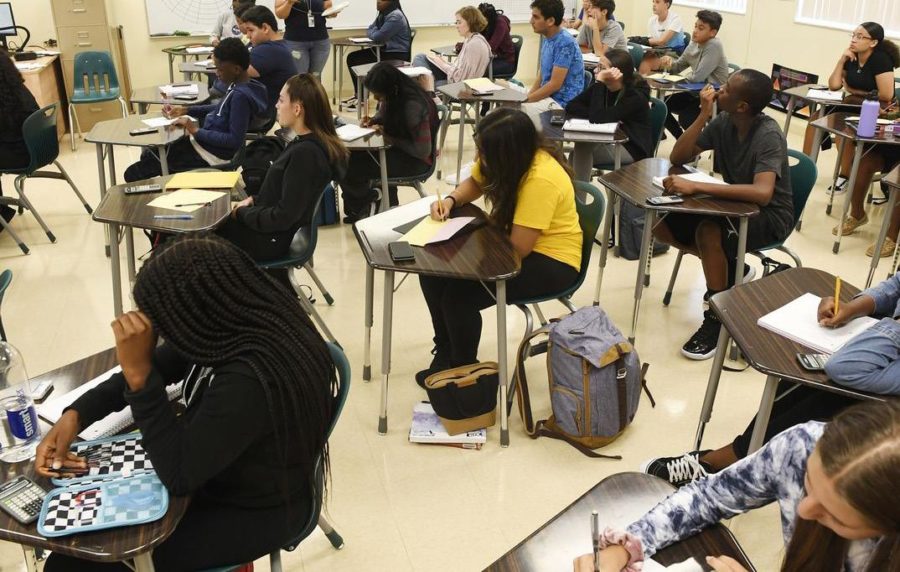Mental Health or Grades?
Admission into college should not jeopardize your emotional well-being.
Seniors at Jupiter High School take notes during math class
December 24, 2021
It is Nov. 30. Senior Laura Hoffman checks her watch, which reads 11:30 p.m. Hoffman has been sitting at her desk, staring at her Common Application for half an hour already. For months, she has been working on and stressing over her essay, her profile and her activities, making sure they are all perfect. Now, she wonders anxiously if it was enough, tearing up as she thinks about how this one click to submit the application could determine her future.
The stress that school alone puts on students is unbelievable. Between 20 and 30 percent of high school students report symptoms of depression, and nine percent of high school students have attempted suicide. Now, combine this with the pressure of college applications, scholarship and financial aid applications, and it is not shocking that every college admissions cycle brings a flood of depression, anxiety and millions of students with poor mental health with it.
The pressure does not stop with students. Suncoast senior Jade McAleer reported, “I had a lot of pressure from my parents and family to have a perfect application. My older sister had an amazing transcript and was able to get into a majority of the colleges she applied to. My parents made me think I had to live up to that and it gave me so much anxiety.” Unrealistic parental expectations can be debilitating for juniors and seniors who already have a lot on their plates.
Along these lines, many students also maintain that their parents do not fully comprehend the sheer amount of work that comes with applying for college. Junior Anna Wong, who is just starting to look at potential colleges, said, “All of the things you have to do as part of your applications are just so overwhelming. It’s like this huge mountain to climb and students are expected to do it all perfectly.” To support Wong’s statement, students are urged by educators, counselors and parents to prepare for college entrance exams, visit college campuses and partake in plenty of interesting extracurricular activities, all while maintaining good grades. Taking on all of these activities is bound to make students sacrifice good mental health.
In the past few years, and especially exacerbated by the COVID-19 pandemic, the already selective admissions process has gotten increasingly worse. As universities strive to raise their nationwide rankings and maintain elite statuses, acceptance rates have been steadily decreasing and the need for perfect stats increasing.
As guidance counselor Nancy Wright said, “Colleges engage in a so-called ‘arms race’ by rejecting more students every year for higher selectivity and rankings.” This results in students applying to more colleges for the fear of being rejected, simply creating a cycle of more applicants and more rejections.
Now, the burden is mostly on colleges and admissions officers to protect the health of America’s high schoolers. To alleviate admissions stress, schools can start by creating a more uniform application process across the board. This would entail identical due dates and similar requirements for individual colleges, among other things. Also, schools should begin taking an entire person and application into account, not just quantitative scores.
“I wish colleges did not require so many standardized tests. They do not tell the whole story and often are not an accurate reflection of the intelligence of a student,” Senior Ella Freeman said.
The stress and pressure that the modern college admissions cycle puts on students is unacceptable. The strain on high schoolers, which gets worse every year, will lead to a serious mental health epidemic among students if colleges are unable to alleviate admissions pressure. The fact remains, the education system’s emphasis on being admitted into a certain college currently comes at the expense of student mental health and emotional and physical well-being.








